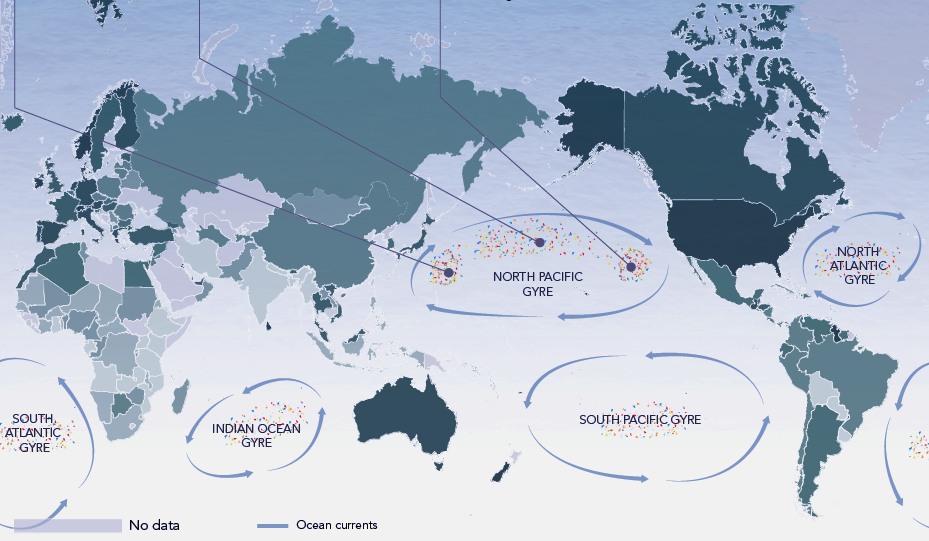So far all the talk has been about plastic in the Pacific Ocean. However, the problem of plastic in our oceans is actually far more pervasious than this. There are a huge range of studies documenting plastic debris all over the world. Given that plastic 'garbage patches' form due to ocean circulation systems, modelling studies have predicted that there are likely to be other garbage patches. During 1963 km of transects Ryan (2014) recorded 281 litter items between 35-35oS in the southeast Atlantic Ocean, which accords closely wit predictions of surface circulation models. Over 97% of the litter was plastic. In the North Atlantic Ocean Moret-Ferguson et al. (2010) analysed 748 selected samples out of more than 18,000 pieces of plastic debris which had been collected between 1991 and 2007. Using chemical analysis the study found the 3 main types of plastic present were high and low density polyethylene, and polypropylene.
 |
| Ocean gyres around the world accumulate plastic. Source. |
Unfortunatley, it seems that no region of the oceans are safe from plastic. Even in remote, isolated, and supposedly pristine regions plastic has found its way there. In a 2015 study using observations from ships and helicopters Bergmann et al. found 31 pieces of plastic litter in the Fram Strait and Barents Sea in the Arctic. The surveys carried out covered over 5,500 linear km giving a mean density of 0.0039 plastic items per km-1. Whilst this density may appear neglible, and is substantially lower than in temperate waters e.g. South Atlantic Ocean (0.1030) or the Bay of Bengal (0.2484), the study highlights the reach of plastic debris pollution into even the remotest areas. Furthermore, climate change is likely to compound the problem. As the sea ice shrinks, the Arctic ocean becomes more open to floating debris, and, simultaneously, anthropogenic activities are expanding into the Arctic bringing sources of plastic debris closer.
 |
| Plastic in the Arctic. Source. |
Travelling from one pole to the other, plastic has been observed in the Antarctic as well. Eriksson et al. (2013) recorded daily observations of marine debris on two sub-Antarctic islands over a three month period. A staggering 6389 items were collected, of which 94.5% was plastic. Eriksson et al. describe two types of plastic: fresh and exhumed (unburied from the beach). During periods of calm the ratio was usually 1:10, of fresh to exhumed. However, during storm events the ratio shifted to favour fresh plastics suggesting a deep sea reservoir of plastic stirred up by the storm. Barnacle ssp. were found on a range of debris, and were used to infer the origins of the debris. A low rate of barnacle ssp. on a portion of fishing gear suggested that it's from regional trawler fisheries for Antarctic toothfish. Interestingly, the first legal longline fishery for toothfish did not start until 2003, but the authors recorded debris consistent with such a fishery in 2001! Aside from hints about the legality (or not) of previous fisheries in the Antarctic, the paper has an important message about plastic monitoring methods. Using daily collections gave a result of debris items 10 times that which weekly collections estimate. This suggests that debris washes ashore everyday but does not always remain there. Given that studies often use weekly, monthly or even yearly observations of plastic, it is likely that these other estimations are likely to be a gross underestimation of an order of a magnitude or more.
Having covered just a fraction of the studies on the extent of plastic in the oceans, I leave you with the fact below. It really is harrowing just how much plastic we have put into the oceans. More than anything, this is a call for change!
 |
| The extent of plastic in the oceans. Source. |


